Please use this identifier to cite or link to this item:
https://accedacris.ulpgc.es/jspui/handle/10553/74442
| Title: | Along-Stream, seasonal and interannual variability of the North Icelandic Irminger Current and East Icelandic Current around Iceland | Authors: | Casanova Masjoan, Maria Pérez Hernández, María Dolores Pickart, R. S. Valdimarsson, H. Ólafsdóttir, S. R. Macrander, A. Grisolía Santos, Diana Torres, D. J. Jónsson, S. Våge, K. Lin, P. Hernández Guerra, Alonso |
UNESCO Clasification: | 251007 Oceanografía física | Keywords: | Atlantic Water Inflow East Icelandic Current North Icelandic Irminger Current |
Issue Date: | 2020 | Project: | Contribución de Las Corrientes de Contorno Del Margen Este A la Variabilidad de la Amoc El Portal Sudatlántico en la Cinta Transportadora Global |
Journal: | Journal of geophysical research. Oceans | Abstract: | Data from repeat hydrographic surveys over the 25‐year period 1993 to 2017, together with satellite altimetry data, are used to quantify the temporal and spatial variability of the North Icelandic Irminger Current (NIIC), East Icelandic Current (EIC), and the water masses they advect around northern Iceland. We focus on the warm, salty Atlantic Water (AW) flowing northward through Denmark Strait and the cooler, fresher, denser Atlantic‐origin Overflow Water (AtOW) which has circulated cyclonically around the rim of the Nordic Seas before being advected to the Iceland slope via the EIC. The absolute geostrophic velocities reveal that approximately half of the NIIC recirculates just north of Denmark Strait, while the remaining half merges with the EIC to form a single current that extends to the northeast of Iceland, with no further loss in transport of either component. The AW percentage decreases by 75% over this distance, while the AtOW percentage is higher than that of the AW in the merged current. The NIIC and merged NIIC‐EIC are found to be baroclinically unstable, which causes the flow to become increasingly barotropic as it progresses around Iceland. A seasonal accounting of the water masses within the currents indicates that only in springtime is the NIIC dominated by AW inflow north of Denmark Strait. Overall, there is considerably more seasonal and along‐stream variability in the properties of the flow prior to the merging of the NIIC and EIC. Over the 25‐year time period, the NIIC became warmer, saltier, and increased in volume transport. | URI: | https://accedacris.ulpgc.es/handle/10553/74442 | ISSN: | 2169-9275 | DOI: | 10.1029/2020JC016283 | Source: | Journal of Geophysical Research. Oceans [ISSN 2169-9275], v. 125 (9), e2020JC016283, (Agosto 2020) |
| Appears in Collections: | Artículos |
SCOPUSTM
Citations
17
checked on Jun 8, 2025
WEB OF SCIENCETM
Citations
19
checked on Jun 8, 2025
Page view(s)
158
checked on Dec 28, 2024
Download(s)
231
checked on Dec 28, 2024
Google ScholarTM
Check
Altmetric
Share
Export metadata
Items in accedaCRIS are protected by copyright, with all rights reserved, unless otherwise indicated.
